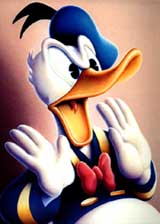 |
Donald Fauntleroy Duck
Story of a character
|
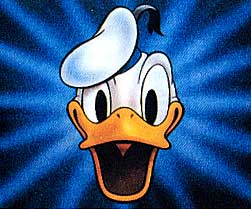 |
| Fonts: This page is created taking reference from various Donald Duck stories and by consulting the books: DONALD DUCK 50 YEARS OF HAPPY FRUSTATION Three Duck Edition 1984, I CLASSICI DEL FUMETTO: PAPERINO Biblioteca Universale Rizzoli 2000, IL MEGLIO DI PAPERINO Disney libri 1999. Other additional information comes from these interesting websites: Life and times in Duckburg , Who's who in Ducburg by Sigvald Grosfjeld Jr. and Calisota by Gilles Maurice. |

|
DUCK AVENGER is no other than Donald Duck, probably the most famous Disney character (maybe even more than Mickey Mouse), for sure the most human and the most loved both by adult and young readers.
We can see in this page a short summary of his story as an element in the contest of Disney production, and as a character of an hypothetic comic reality. |
| Donald Duck the Disney myth |
| It seems that the first prototype of the most successful and popular Disney character appeared in the Disney story book THE ADVENTURES OF MICKEY MOUSE published in 1931 by David McKay. This book is interesting because it mentions some of Mickey's friends in the old barn and barnyard. One of them is Donald Duck, a nice young duck with a not much of an antropomorphical aspect drawn with the typical Disney style of the black and white characters of the 30s. |
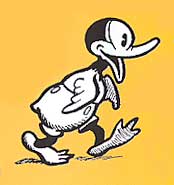
First Donald "prototype" |
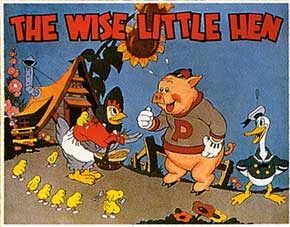 |
The official appearance of Donald Duck (full name Donald Fauntleroy Duck) is in June 1934 in the film THE WISE LITTLE HEN Disney 45th SILLY SYMPHONIES, where a small angry and funny duck, animated and drawn by Art Babbitt and Dick Huemer, was one of the characters. |
For some time Disney wanted a new character other than Mickey, maybe aquick-tempered and tiresome person and he wanted to utilize a duck or a goose.
Disney chose the first animal after hearing the voice of Clarence Nash, who was the inspiration for the personality to give to this new hero. |

Clarence Nash,
Donald Duck's voice |
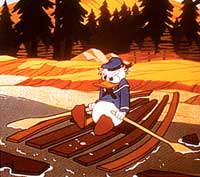 |
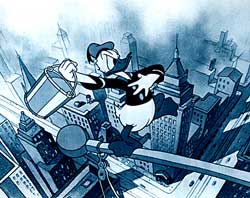 |
Donald was revolutionary both for the drawing and for the personality, all the other characters were much easier to create but they had a less expressive possibility. With Donald the producers had in their hands a real actor with a great versatility.
During the 30s several succesful movies were created and in the following years, in the smart hands of Jack Kinney e Jack Hannah, Donald reached his definite success in some unforgettable movies.
|
| Not so bad for a character which in the Disney fantasy was born on Friday the 13th of March 1934 (imaginary date because the 13th of March 1934 was not a Friday but a less "superstitious" Tuesday). |
| In the same time as his appearance on the big screen, Donald started to be utilized in the comics as well with the first album published in 1935 THE WISE LITTLE HEN (printed version of the famous movie) and the first book dedicated to DONALD DUCK where he is the protagonist of a short story together with Mickey Mouse's nephews. |
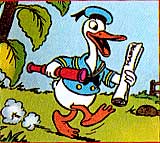 |
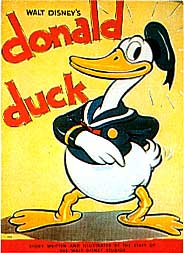 |
| Donald was pretty soon used by Floyd Gottfredson and his staff as a sidekick to animate the stories of Mickey and Goofy in the Sunday and daily comic strips. |
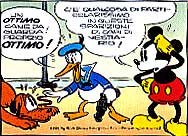 |
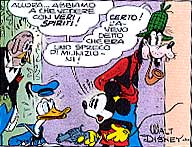 |
Famous are the police-style adventures such as THE CASE OF THE VANISHING COATS 1935, MICKEY MOUSE RUNS HIS OWN NEWS PAPER EDIT-IN-GRIFF 1935 and particularly MICKEY MOUSE AND THE SEVEN GHOST 1936. |
| Donald, Mickey, Goofy and Pluto by Floyd Gottfredson |
| In 1937 Floyd Gottfredson commisioned Al Taliaferro to create a series of daily strips completely dedicated to Donald. Taliaferro adjusted the character's aspect to the definitive version of the animated one (short and large beak, "normal" height big head and eyes, more antropomorphical aspect). He decided together with the Disney management to not utilize the character for long adventurous stories, but only in short and funny gags. |
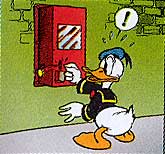
Al Taliaferro |
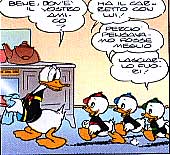 |
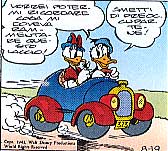 |
In those years (taking reference from the nephewes of the HAPPY HOOLIGAN of Frederick Burr Opper) were introduced Huey, Dewey, and Louie 1937 the Donald's nephewes and subsequentelly other important characters as Daisy Duck 1940 and Grandma Duck 1943 whitout to forget the famous 313 Donald's small car. |
| Donald, Daisy and nephews by Al Taliaferro |
While in the United States nobody had yet used Donald as the protagonist of long and adventurous stories, in Italy he was placed in this more important role by Federico Pedrocchi, who was the director of the weekly Disney comic journal TOPOLINO.
In fact, at the end of 1937 the Italian weekly journal PAPERINO published the first famous long story PAOLINO PAPERINO E IL MISTERO DI MARTE (DONAL DUCK AND THE MARS MYSTERY).
In Italy one of the most important Disney schools in the world was founded which produced some of the most beautiful stories about Donald even written, and which were republished in many other countries. |
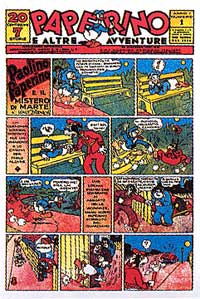 |
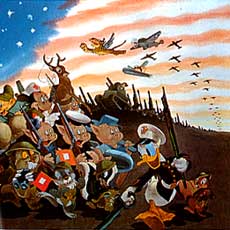
| During WWII, while in Italy the comic production was interrupted (also Pedrocchi died during an aircraft-gun fire against the train which carried him every day from his town to Milan), in the United States Donald other than appearing in the comics is the protagonist and testimonial of several movies against the nazist regime (winner of several Academy Awards), and of some important campaigns for the United States government, as for instance to form a strong bond between longtime American citizens and the new Latin imigrants and to convince the population... to pay their taxes. |
After the war, a second career began for Donald. In the United States the artist Carl Barks further developed the character making him reach a Myth-status.
He invented the most important companions of Donald: Gladstone Gander 1948, the Beagle Boys 1951, Gyro Gearloose 1952, the witch Magica de Spell 1961, but most importantly the rich and stingy uncle Scrooge McDuck 1947.
Barks gave a name to the ducks' city, Duckburg 1944 and started the typology of stories and social-cultural environment which influenced most of the future Disney ducks productions realized both in the USA and in other countries. |
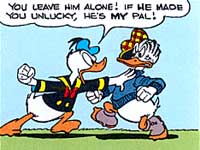
Carl Barks |
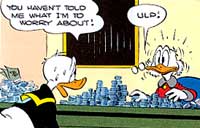
Carl Barks |
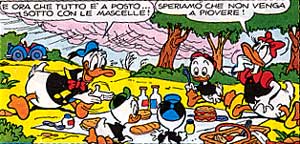
Donald - Made in Italy |
In the same time as the Barks' stories, the Italian production with authors like Guido Martina, Giovan Battista Carpi, Luciano Bottaro, Romano Scarpa, Pier Lorenzo and Massimo DeVita, Giorgio Cavazzano, Marco Rota and several others continued to develope the character of Donald and remaining almost always faithful to the Disney spirit of Gottfredson, Taliaferro but over all of Barks, they created great adventures reprinted, translated and published in several countries, creating new characters to what has been called "The big duck family". |
| Of these stories made in Italy, the ones called parodies are probably the most characteristic ones which have seen Donald playing several famous historical literature characters like PAPERINO DON CHISCIOTTE 1955, IL DOTTOR PAPERUS 1958, PAPERIN DI TARASCONA 1957, EL KID PAMPEADOR 1959, PAPERIN FURIOSO 1966 PAPERIN FRACASSA 1967, PAPERIN DE PAPERAC 1967, PAPERIN ALÌ 1985 and much more. |
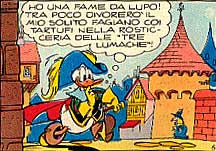
Paperin De Paperac |
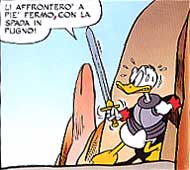
Paperin Furioso |
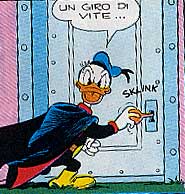
DUCK AVENGER the devilish avenger |
In 1969 the same Italian artist group had created Donald's secret identity and alter-ego Paperinik (for which the most appropriate English translation is "Duck Avenger"). With a black costume which originally belonged to the gentleman thief Fantomallard and a mask to hide (but not much) his identity, Donald had Gyro create a secret hideout under his house, while having him modify his car with several special devices to accomplished his night revenge missions.
His adventures had a big success and have been reprinted in several other countries. |
| Always in Italy in 1996 the hyper-technological super-hero version of Duck Avenger was created called PK (in the beginning short form for Paperinik than transformed in that for the scientific latin name Platyrhynchos Kineticus "energized duck" but in USA also known as Duck Avenger or Super Duck). This character which has nothing to do with the original Duck Avenger, lives in a futuristic habitat similar to the one of some American super heros where he acts in interdimensional complex and charming adventures but that are completely out of the classical Disney universe. |
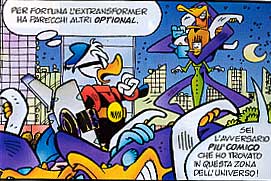
PK "Platyrhynchos Kineticus" |
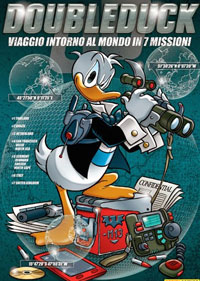 |
In Italy in the 2008 was also created by Max Monteduro another secret identity of Donald named Doubleduck. In this identity he is a Special Agent working from a misterious Intelligence Agency so secret that it has no name. The character is based on the British Agent James Bond 007 by Fleming, Also in this case because of his psico-phisic quality and the tipology of adventures, this character is completelly out of the classical Donald Duck being these spy-story more likely a parody of the James Bond or Mission Impossible adventures. |
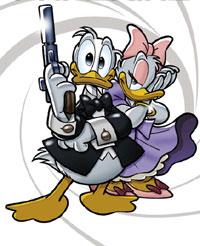 |
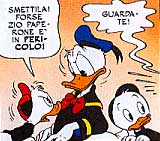
Miquel Pujol |
Among the various authors who have written Donald stories worth mentioning in various countries, are those had worked for the Disney "Studio Program", (the Disney project for export comics) such as Dick Kinney and Al Hubbar creators of Donald's cousin Fethry Duck 1964, Tony Strobl, Jack Bradbury and important great artists like the Chilean Victor Arriagada Rios, better known as Vicar, who takes much from Barks reference, or the Argentinian Daniel Branca (both collaborators of the Danish publisher Egmont). The Spanish José Cardona, Miquel Pujol and José Maria Colomèr Fonts, the Olands Daan Jippes and Fred Milton, and the Brasilians Carlos Herero, Irineu Soares and Roberto Fukue. |
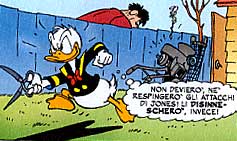
Daan Jippes |
| But who mainly took over Donald according to Barks' stories, are the American artists William Van Horn and Don Rosa. Of the former, one story drawn worth mentioning is the famous HORSING AROUND WITH HISTORY 1998, a ducks adventure written by Barks himself when he was 93 years old. |
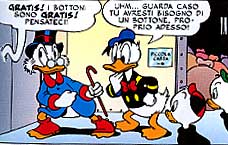
William Van Horn |
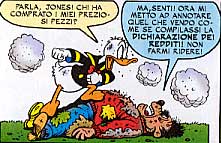
Don Rosa |
while Don Rosa is for sure the author able to better interprete spirit of Barks' stories, his great works about Scrooge McDuck's life story THE LIFE AND TIMES OF SCROOGE MC DUCK 1994-1996 (where the most credible logical and reasonable correct version of Donald birth and youth has been represented) and his marvelous and well thought duck family tree are the most evident proof. |
| No longer used in the cartoons (in the series DUCK TALES he is basicly absent), today Donald continues to excite adults and children in the comics thanks to the above mentioned artists in several parts of the world, remaining the immortal character in which all of us can identify ourselves a little bit. |
| TOP |
| Donald Duck - an hypothetic life story |
Several versions have been written and drawn about the Donald's birth and youth imagined as a character of an hypothetic comic reality. Neglecting those more or less legendary like a birth in stormy night and casually entered into the Disney Studios, or those not much credible and too simple like an egg fallen from a tree and found in the middle of the street with subseguent adoption by not related ducks who later on are identified as scrooge and grandma.
I believe that the most reasonably acceptable version is the one shown for the first time by Don Rosa in chapters 10 and 11 of Scrooge McDuck's life saga, and in several other facts contained in his other stories (hopefully others will be created in the future). These origins are well thought and are the result of a meticulous and passionate research and analysis of stories, sketchs and conjectures of artists such as Barks, Taliaferro, Hubbard, Strobl and others.
Of course in addition to the indications taken from Don Rosa's stories, I have included pertinent informations coming from stories of other Disney artists both Italian or of other countries in order to fill in some period gaps. |
| THE BIRTH AND CHILDHOOD (Don Rosa, Carl Barks, Strobl) |
Donald Fauntleroy Duck was born in 1920 in Duckburg through the union of Hortense Mc Duck (Scrooge McDuck' sister) and Quackmore Duck (third born to Elvira Coot-better known as Grandma Duck- and Humperdink Duck).
The new about Donald and Della birth was also published in 1920 on the Duckburg Times. |
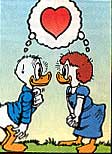
Donald's parents (1902) |
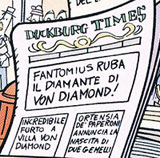
Donald and Della birth new on Duckburg Times (1920)
|
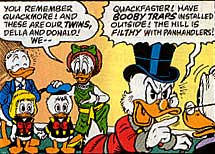
Donald and his sister Della (1930) |
Donald has a twin sister Della Duck, and of his closer relatives whose worth mentioning are the cousins Gladstone Gander, Fethry Duck and Abner Duck, the uncles Scrooge McDuck, Matilda McDuck (the other Scrooge's sister who will have a relationship with Ludwig Von Drake), Daphne Duck and Goostave Gander (Gladstone's parents), Eider Duck and Lulubelle Loon (Fethry Duck and Abner Duck's parents), while uncle Gideon McDuck (created by the Italian artist Romano scarpa but not shown in Don Rosa's Duck family tree) can be considered logicly Scrooge's half-brother, son of a second "unofficial" relationship of Scrooge McDuck's father Fergus McDuck. |
In 1930 the young Donald met his rich uncle for the first time, who discovers the quick-tempered personality of his nephew on his own skin, or better on his own piumage.
The interruption of relationship between the greedy rich duck and his family can be seen in this context, because they would not have any further contact until Christmas 1947. |
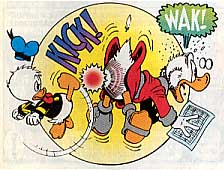 |
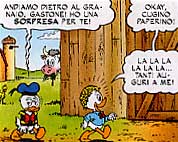
Donald and his cousin Gladstone (1932?) |
In Don Rosa's funny story THE SIGN OF THE TRIPLE DISTELFINK some sequences of Donald and Gladstone's youth are shown with "interesting references to the well known good luck of Gander and the also well known "selfdestructive tendencies" of Donald. |
| From this and other stories (among which also the recent Italian trend stories Paperino Paperotto about the young Donald's life) we can deduct that Donald has lived during his childhood and youth together with his parents and sister in his grandparents' farmhouse outside Duckburg. |
| THE AGE OF MATURITY (Gottfredson) |
| When he reached maturity (thus in 1938) Donald left his grandparents' farmhouse and -as shown in the THE WISE LITTLE HAN- he goes to live on his own in a houseboat along a river in Barnyard Village, also located in the country outside Duckburg. |
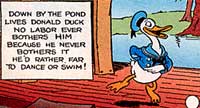
Donald teen-ager (1938) |
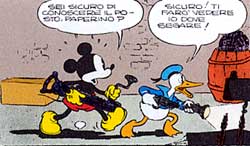
Donald in Mousetown (1940) |
Then he moved (probably to search work and adventures) to Mousetown where he met Mickey Mouse and Goofy and togheter with them he lived several adventures (shown by Gottfredson). In this city he works as paperboy, detective's apprentice and Mickey's nephews Morty & Ferdy's babysitter. |
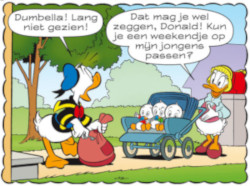
Della Duck with infants Huey, Dewey, and Louie with Donald probably just before his departure for the military service (1942) |
During WWII we don't have any references if Donald had been enlisted in such kind of military service. Thus we can immage him as we prefer: or unfit to the active military service due to some psycho-physical lack (as happened for the too short Mickey and for the not very stabil Goofy), or -if we want to follow a certain logic- because of his undenyable passion for the sea, considering the area of his origins, taking into account the numerous stories where he proved to have ability to fly and a good ability as a mechanic, we can image him as a volontary enlisted in the US NAVY, first as a technician and than as a pilot of the Naval Aviation during the Pacific war. |
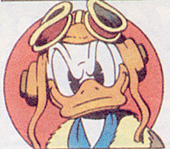
| 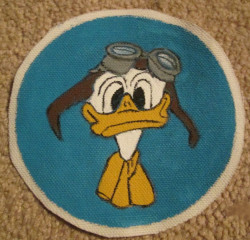
Donald Naval Aviator?
(1942-44) |
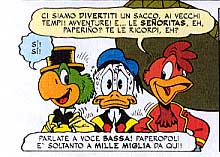
Donald, Panchito and Josè (1945) |
After the military service the young Donald continues to travel searching adventures along California and the near Mexico. His meeting and friendship with Panchito and Josè Carioca can be placed in this period together with them he lived several fun and unforgettable adventures creating the famous trio known as The three Caballeros.
|
| A YOUNG AND SMART DUCK (Taliaferro, Barks, Don Rosa) |
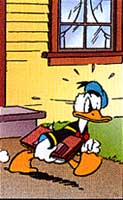 |
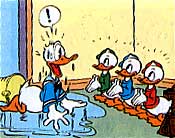
Donald adopts his three nephews
(1946?) |
Coming back to Duckburg Donald goes to live in a suburban house, he got his famous licenced plated 313 car (Don Rosa shows us that this car was built by Donald himself utilizing parts coming from old cars: a Mixwell engine from 1920, a Dudge body from 1922 and Paclac half-shaft from 1923), he holds numerous jobs, meets Daisy but most importantly he adopts his three nephews (they were born in 1942 and remained orphans at the age of four or five) sons of his sister Della and Daisy's brother of whom even today we don't know the name. |
| After the short gags of Taliaferro, Carl Barks shows us several situations placed in this time, the funny stories of tricks between Donald and his nephews, the long and elaborate adventures in the most lost and strange places in the world, the various jobs held by Donald like for instance: fireman, icecream man, trashman, pilot, sailor, nightguard, do-all-inventor etc.. In that period Donald has completely demostrated that he doesn't deserve the to be called good-for-nothing (especially later on by his uncle Scrooge). |
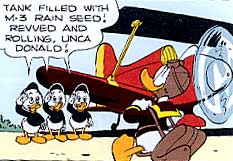 |
| THE FAMILY REUNITES (Barks, Don Rosa, Van Horn, Vicar) |
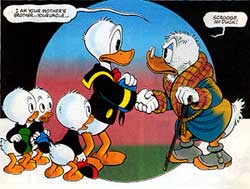
Scrooge meets his nephews
(December 1947) |
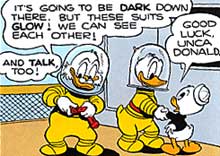
The great adventure with uncle and nephews
(1948-1953) |
It is Christmas in 1947 when the rich uncle Scrooge, which for many years after a disapointment with his family had lived alone, decides to call up Donald and his nephews (as shown in Barks' story CHRISTMAS ON BEAR MOUNTAIN and in the 12th chapter of Don Rosa's saga THE RICHEST DUCK OF THE WORLD). After a not so good start he makes peace with his relatives and together with them he begins a new youth searching for lost treasures, exploring the most remote places on the earth and even of other worlds, in a series of famous adventures located in the early 50s, marvelously realized by artists such as Barks, Don Rosa, Van Horn, Vicar... and various others. |
| DONALD ADULT - THE ADVENTURE GOES ON (Italian artist: Martina, Carpi, Scarpa, De Vita, Rota etc...) |
| After that period (thus not shown in Barks' and Don Rosa's stories) we can logicly include some facts coming from Italian stories in order to amplify in credible and reasonable way Donald's life without contrasting with what is shown in the stories by the American artists. |
These are the years where Donald and his nephews, sometimes because obligated and almost always because blackmailed by Scrooge, continued the great explorations to search new treasures. In these adventures they use strange and unusual machines which are normally created by Gyro. In this period, Donald who always had financial problems, moved in a new house owned by Scrooge, while the richest duck of the world changed the look of his moneybin, adding a big dom on the roof typical of the Italian stories.
Other friends and relatives appeared as Scrooge's half-brotherGideon McDuck, who (in order to avoid a contrast with the Barks/Don Rosa family tree) can be considered as illegitimate son of Scrooge's father, who was unknown (maybe he was in Scotland up till now). Scrooge McDuck's admirer Brigida McBridge created by Romano Scarpa and appreciated by Barks, and Dickie Duck created by Scarpa as well. The latter is "Glittering" Goldie O'Gilt's granddaughter and maybe (but this is only an assumption) also the granddaughter of Scrooge, praticly she could be the daughter of the presumed (but not proven) daughter born from the relationship between a young Scrooge and Goldie in the Klondike in 1897. |
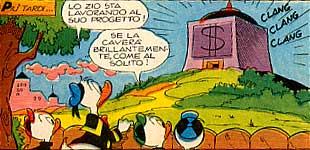
The Money bin's new look (1955?) |
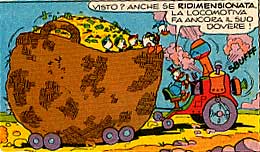 |
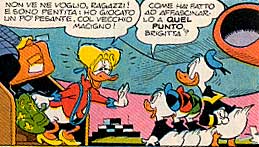
Donald's nephews and Brigida McBridge |
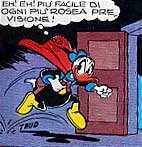
Donald's double identity (1955?) |
But overall it is in this period that Donald, with a big streak of luck, found the diary and costume of the gentleman thief Fantomallard in Villa Rose. He began the adventure of his secret double identity helped by his trustworthy friend and inventor Gyro Gearloose who built the secret hideout, modified the car and equiped Donald with several special devices. And so, our beloved duck became the feared Duck Avenger. |
| The continuous and sometimes forced adventures and explorations with uncle Scrooge and the stress to keep a double identity tired Donald always more, and in thus in this period he had always more difficulties to find stabil and steady jobs... this is the time of debts, blackmails and the worthless jobs offered by his rich uncle. |
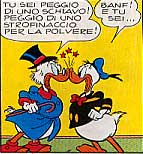 |
| A HYPOTHETICAL FUTURE (Barks, Don Rosa) |
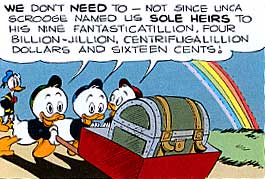
Huey, Louie, and Dewey are nominated heirs of Scrooge |
There are not many references about a hypothetical future of Donald and his family. From some references of a Barks story published in WDCS 155 1953, and in the Don Rosa adventure NOBODY BUSINESS we can deduct that Huey, Dewey, Louie are nominated by Scrooge the only heirs of his fortune. It is thus logical to suppose that after Scrooge's death, in 1967 at the venerable age of 100 years (as it was shown by Don Rosa in a famous and sad illustration) the now adult nephews have taken over the management of the family fortune, having demonstated in several occasions to be better amministrator than Donald or Gladstone.
From the same drawing we can deduct that Donald and Daisy got married but we don't know if they ever had children. There are different opinions about this. First one supposes that because Donald had raised his three nephews he is now less motivated to have children of his own. The other hypothesis comes from a Brasilian story by Soares Rodrigues, Rodavin de Mello e Miyaura where Donald and Daisy are parents of six kids, four male and two female, but the story was a dream of Donald, so it can't be considered as an official reference, even if sometimes the expedient of a dream allows to shows some "truths" otherwise censured! |
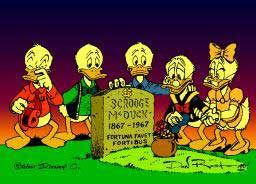
Donald, Daisy and nephews at Scrooge's grave
(about 1990) |
| Many years have passed since 1920. Our fantasy can imagine an old duck, tired of adventures and after definitly having hung up the DUCK AVENGER costume, thinking about his relatives now gone or too busy to take care of him....or maybe, why not have Donald start a second youth together with his rich nephews continuing to explore the world searcing for treasures and new adventures, just as many years before had happend to his uncle...but fortunately those stories will never been told! |
"Donald has the greatest of all virtues: courage when faced with adversity"
HELEN G. THOMPSON, author
|
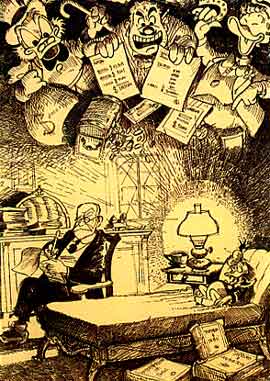 |
| TOP |
|

